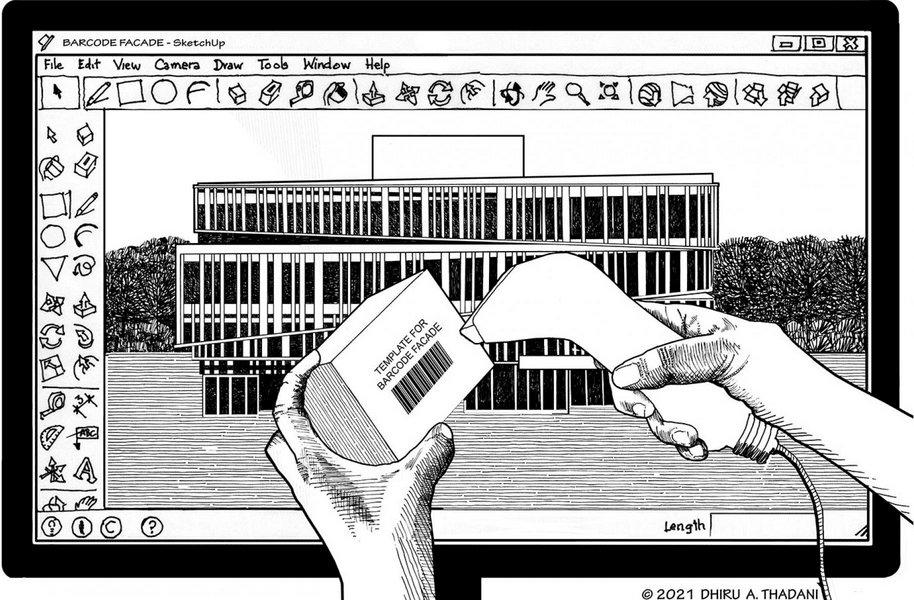Search Posts
Recent Posts
- Detailing Manhattan: Christopher Gray’s Legacy – David Brussat April 26, 2024
- Business Beat: BankNewport supports Kids’ Zone at new Save The Bay Hamilton Family Aquarium April 26, 2024
- Rhode Island Weather for April 26, 2024 – John Donnelly April 26, 2024
- GriefSPEAK: Dread. Fear. Welcome relief. – Mari Nardolillo Dias April 26, 2024
- Outdoors in RI: big animals, tiny Ticks, huge Trout, Chepachet’s Harmony Railway, 2A – Jeff Gross April 26, 2024
Categories
Subscribe!
Thanks for subscribing! Please check your email for further instructions.

A lexicon of modern facades – David Brussat
by David Brussat, Architecture Here and There, contributing writer on architecture
Illustration by Thadani of how lexicon can be used on computers. (Dhiru Thadani)
Among the many differences between modern architecture and traditional or classical architecture is that modernist buildings, which often do not look like buildings at all, receive what I call derisive monikers from members of the public. Traditional and classical design, on the other hand, results in buildings that look like what they are supposed to be. Churches look like churches, banks look like banks. Houses look like houses. (What an idea!)
Recently, in Providence, new bus waiting kiosks have appeared in downtown that look like ironing boards, or (to me) like apparatuses that belong in a torture chamber. Other familiar names for modernist buildings are Big Pants, an official nickname for the CCTV headquarters, in Beijing, adopted in order to forestall some other nickname for a building that, to me, looks like it is stomping on the Chinese people. Also in Beijing is the Bird’s Nest, its Olympic stadium. Others think it looks like a massive tangle of barbed wire. I don’t know whether Beijing’s headquarters for the People’s Daily newspaper has a nickname. I’m sure it must. It looks like a giant penis. Not to pick on Red China, London has its own dildo, referred to as the Gherkin, meaning cucumber, which is often used as a … oh, never mind. Urban psychoanalysts, especially female, have for ages referred to all buildings taller than wide as phallic symbols.
You could list dozens more, but you don’t have to because Dhiru Thadani, the D.C.-based architect and urbanist, has done it for you. He has just developed a lexicon for typical styles (or “styles,” modernists might say because they claim not to believe in styles) of modernist building design. The derisive monikers he has come up with for each style are apposite, and for the most part describe with cunning accuracy what most people will see as the clear inspiration for these works to which the profession of architecture has stooped. Many of the styles below probably appear in your own community, buildings that the public rolls its eyes at and wishes were somewhere else.
Here is the lexicon, which also depicts the modernist building styles:
Many readers will recognize the original buildings from which the styles take their names. Despite familiar assertions to the contrary, modernist architects are deeply indebted to copying the past for their productivity. So readers may have seen one or more “derivative” buildings that bow down, or get down on their knees, in deference to the originals.
Thadani expertly explicates his lexicon in text accompanying his article in Public Square, the space usually filled by new urbanist Rob Steuteville. I recommend reading the whole thing, which is relatively brief, but here’s one passage I love:
It is ironic that today’s modernist architecture has reverted to being skin deep with no regard to express the functional use of the building. Many new buildings are designed to be appreciated from the air, as if to assume that all citizens have helicopter access. The pedestrians and street views are ignored. The majority of buildings do not contribute to the beauty of their context but rather try hard to stand out using absurd anti-gravitational strategies.
I will give a prize, of sorts, to the reader who can identify, in my comments section, the most original buildings represented in the lexicon.
To read all of Brussat’s article from RINewsToday, go here: https://architecturehereandthere.com
_____

My freelance writing and editing on architecture and others addresses issues of design and culture locally and globally. I am a member of the board of the New England chapter of the Institute of Classical Architecture & Art, which bestowed an Arthur Ross Award on me in 2002. I work from Providence, R.I., where I live with my wife Victoria, my son Billy and our cat Gato. If you would like to employ my writing and editing to improve your work, please email me at my consultancy, [email protected], or call (401) 351-0457 https://architecturehereandthere.com/

